Introduction
Welcome to the future of AI integration. As we continue to push the boundaries of what is possible with technology, it's crucial for IT professionals and businesses to stay ahead of the curve. This post will guide you through the most innovative strategies for AI integration, providing insights into how these cutting-edge technologies can drive your business forward.
1. Leveraging Cloud and Edge Computing
Cloud computing has revolutionized the way we store and process data. However, as we move forward, edge computing is becoming an increasingly important part of the AI integration strategy. Edge computing involves processing data closer to the source, reducing latency and providing real-time insights. This is particularly useful in AI applications that require instant decision-making, such as autonomous vehicles or healthcare monitoring systems.
// Example of edge computing in action
const edgeDevice = new EdgeDevice();
edgeDevice.processDataLocally(data);
2. Utilizing Machine Learning and Deep Learning
Both machine learning (ML) and deep learning (DL) are powerful tools in AI integration. ML algorithms can learn from data, improving their performance over time, while DL algorithms can learn from unstructured data, making them incredibly versatile. Utilizing both ML and DL in your AI integration strategy can provide a more comprehensive and effective solution.
// Example of a deep learning model
const model = new DeepLearningModel();
model.train(data);
model.predict(newData);
3. Embracing Open Source AI Frameworks
Open source AI frameworks such as TensorFlow and PyTorch have made AI more accessible than ever. These frameworks provide a platform for building, training, and deploying AI models, allowing developers to focus on creating the best possible solutions without worrying about the underlying infrastructure.
// Example of using TensorFlow
const model = tf.sequential();
model.add(tf.layers.dense({units: 1, inputShape: [1]}));
model.compile({optimizer: 'sgd', loss: 'meanSquaredError'});
4. Integrating AI with IoT
The Internet of Things (IoT) is another exciting area of AI integration. By combining AI with IoT devices, businesses can create smart systems that are capable of making intelligent decisions based on real-time data. This is particularly useful in industries such as manufacturing or agriculture, where real-time data analysis can result in significant efficiency gains.
// Example of AI integration with IoT
const device = new IoTDevice();
device.on('data', data => {
const prediction = aiModel.predict(data);
device.act(prediction);
});
Conclusion
The future of AI integration is bright, and it's clear that businesses that fail to embrace these technologies will be left behind. By leveraging cloud and edge computing, utilizing machine learning and deep learning, embracing open source AI frameworks, and integrating AI with IoT, businesses can stay ahead of the curve and drive their success forward.
Remember, the future is now. Stay current, stay informed, and most importantly, stay innovative.